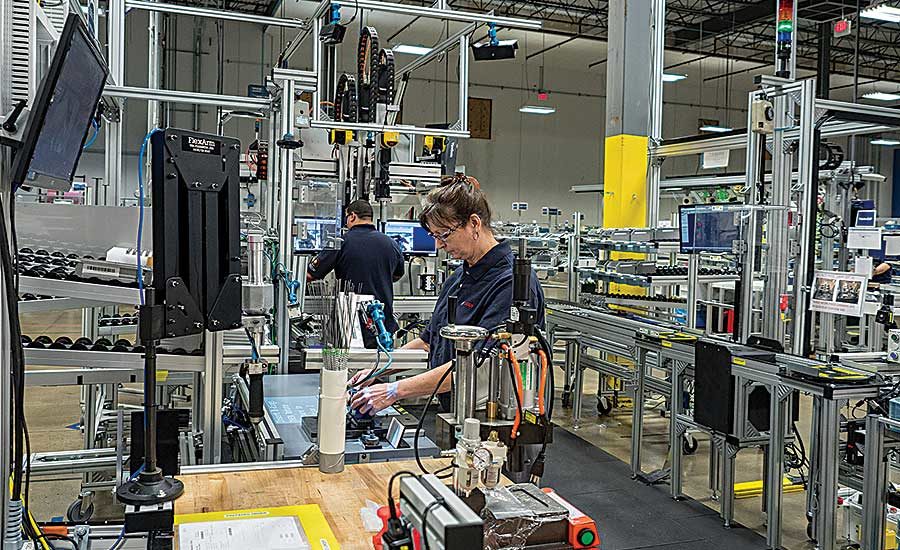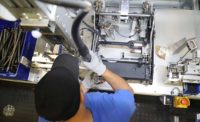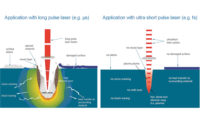Parts come in all sizes, shapes and weights. But, any type of part isn’t good until it’s at the right location, at the right time and at the right height on assembly lines.
Precise parts positioning is essential to achieve throughput levels, reduce errors, eliminate waste and boost productivity.
Manufacturing engineers have many options for presenting parts to workers. Three of the most popular methods used in flexible, mixed-model production environments are flow racks, parts kitting and pick-to-light systems.
Today, properly presented parts are more important than ever.
“External pressures, such as customer-mandated cost reductions, higher quality expectations and tighter supply chains requiring improved delivery performance, are increasing the internal role of parts presentation,” says Kurt Greissinger, vice president of Lean Factory America LLC.
“Improper parts presentation and planning could even shut down production,” warns Greissinger. “Parts presentation is also under more scrutiny as ergonomic requirements continue to develop and gain attention.”
“Changing customer demands are transforming the manufacturing industry,” notes Brian Neuwirth, vice president of sales and marketing at UNEX Manufacturing Inc. “Organizations must incorporate flexibility and agility into their supply chains to create value and sustainability.
“Customers want more custom products, quicker,” Neuwirth points out. “Manufacturers must ensure their assembly lines are agile enough to meet these needs, while keeping costs in check and speeding time to market.”
Many manufacturers are measured by their superior products, excellent customer service and quick time to market. Assemblers need to be able to quickly and easily grab parts to complete their tasks.
“Speeding assembly operations with proper part presentation can reduce movements, save on labor costs and time, improve productivity and improve efficiencies,” claims Neuwirth. “Getting assemblies to the right location at the right time ensures customer orders will be met on time.”
“Parts presentation is a key factor in work efficiency,” adds Lori Bechtler, product manager for manual production systems and aluminum at Bosch Rexroth Corp. “If operators are waiting for parts or leaving work areas to gather parts for production, that is waste.
“Extra reaching, unnecessary movement in and around the workcell, and parts placement without regard to the assembly sequence [is also] waste,” Bechtler points out. “It can be discovered quickly with time and motion studies, or even by simple observation with a stop watch.
“With increasing pressures on profitability, companies are looking for ways to reduce production time, eliminate root causes of errors, and produce a broader range of parts with the same amount of labor,” says Bechtler.
According to Bechtler and other observers, the way that workstations and material are organized can impact both ergonomics and productivity. Both go hand in hand.
“Many people think ergonomics is related mostly to operator comfort,” says David Verrill, applications support manager at IAC Industries Inc. “That’s true. But, true ergonomics involves ready identification of parts, [fewer] reaches and [less] time away from the workstation to access parts. The net result of improved ergonomics is also increased productivity.”
The French phrase mise en place [“putting in place” or “everything in place”] is often associated with cooking techniques. But, it can also be applied to parts presentation.
“This makes a nice analogy to assembly work, as proper planning and prep work results in a more efficient output,” notes Verrill. “I like to think that it also results in higher quality products.
“Effective parts presentation is about reflexive identification and access to those parts, and then assembling them correctly and efficiently,” explains Verrill. “[Because] so much production in the United States is based on lower volumes and higher operator expertise, parts organization and presentation directly affect throughput.”
Lean Layout
Lean layout plays a key role in effective parts presentation. Engineers should consider lean methodologies when creating the physical layout, taking into account operator movement, redundancies and other factors.
“Unfortunately, many engineers don’t think about getting parts to the operator until after they’ve designed an assembly line,” says Rick Harris, president of Harris Lean Systems Inc.
“With lean manufacturing, the goal is always to eliminate the number of touches and enable operators to make the least amount of moves possible,” says Harris, a former engineer at General Motors. “Parts that are not at an operator’s fingertips will cost a manufacturer 30 percent in lost productivity.”
“Efficiently getting parts to the operator’s fingertips can take a great deal of engineering,” explains Harris. “However, material handling is typically an afterthought at many companies.”
“Manufacturers such as John Deere and Toyota have realized that putting too much material in front of operators is usually a bad idea that runs counter to lean principles,” adds Richard Rahn, principal of Leonardo Group Americas, a consulting firm that specializes in lean material handling. “It increases the chance that the operator will reach out and select the wrong part.
“When you stock too much material at the workstation, the value-added time of the operator goes down,” explains Rahn. “The amount of material you stock at each workstation also increases the physical size of the assembly line.”
Rahn believes that anything that prevents having the right part in the right quantity, time, quality and place is waste. It’s a sign of an unstable production process, because waste elimination and a pull system are tenets of lean manufacturing.
Parts Presentation Options
Workstations play a critical role in effective parts presentation.
“An ergonomically designed workstation with a robust combination of accessories is crucial in today’s manufacturing environment,” says Dan Smith, national sales manager at Treston Inc. “Motorized height-adjustable workstations can provide a flexible station to fit the needs of different [assemblers]. They are especially valuable in places with high turnover or shift work where multiple [assemblers] use the same workstation throughout the work week.”
Manufacturers have many options for presenting parts to assembly line workers, including flow racks, kitting and pick-to-light systems. Each has pros and cons that engineers should carefully consider.
Some methods are more expensive than other alternatives. Sometimes, a simple, manual system may work just as well as an automated one.
“[A good] way to evaluate the best solution is to consider the severity or risk of selecting the wrong part,” says Greissinger. “Another consideration is the takt time of the line. Some workstations may consume parts at higher rates than others, requiring more parts to be presented line side or delivered at a higher frequency.”
Flow racks are popular, because they can be replenished from behind without disturbing assemblers. However, most experts suggest using small bins or containers that don’t weigh more than 35 pounds.
“Gravity-fed flow racks may help, but under extreme circumstances the operators may not even have time to dispose of an empty bin,” notes Greissinger. “This is where flow racks outfitted with karakuri—low-cost automation based on gravity, springs, counterweights and levers—can enable a one-touch or no-touch box exchange.”
“Flow racks are essential for lean manufacturing,” says Harris. “But, the shelving should always be adjustable. If it’s engineered correctly, the operator should have no choice but to do first-in, first-out. Simple two-bin systems are ideal for fasteners, nuts and other highly repeatable, low-cost items.”
Kits of parts can also help reduce line-side footprints and make it easier for operators to do their job. Each kit should give assemblers all the parts and tools necessary to complete the specific components they are building.
“Frequent product changeover requires a certain degree of repeatability,” says Verrill. “For instance, three different product builds require different hardware kits, depending upon the product being assembled.
“If parts are fed to the operator with different kits for each product build, the kit itself usually should be located in roughly the same access position,” adds Verrill. “Non-related parts for any given build should be removed from the area to ensure accuracy.”
Kitting works well when you have a small area to present parts and many parts are required. But, it comes at a price. It typically takes five times longer to kit parts as it does to deliver parts.
However, many manufacturers have benefitted from parts kitting. “Toyota’s Georgetown, KY, plant recently achieved a 5 percent improvement in productivity, even though they had to add extra people to prepare the kits,” notes Rahn.
Pick-to-light systems are another parts presentation option. They are typically used on high-mix, low-volume assembly lines.
“Traditional pick-to-light technology provided a step along the path of making work instructions more visual, visible and available to operators,” notes Paul Ryznar, CEO of OPS Solutions LLC. “By activating a pick light on or near the pick location, manufacturers can naturally draw the operator’s attention to the correct pick area. The process can also be partially error-proofed by requiring an operator confirmation—typically via finger swipe—of the action.
“Pick-to-light has been an extremely valuable tool, but the legacy technology has some gaps,” claims Ryznar. “Pick lights are small and can be hard to locate in a large cell, and the finger swipe is an imperfect and easily bypassed confirmation. Maintenance of the systems is also complex with so many separate pieces.
“Augmented reality technologies allow us to fill many of these gaps,” Ryznar points out. “By using projection-
based augmented reality, combined with various sensors, the whole parts bin or area can be lit up without additional hardware. In this scenario, confirmation occurs based on actually reaching into the bin rather than requiring a secondary action, such as a finger swipe.
“Projection-based augmented reality represents the next evolution in advancing manufacturing technology to make factory floors smarter, safer and better,” says Ryznar. “[It projects] a digital operating canvas directly onto virtually any work surface. Systems can be programmed to provide audio and visual prompts, guidance, pacing and direction to drive manual processes with speed and precision.”
According to Ryznar, this state-of-the-art technology ensures that operators have the right part at the right time and place to build each component or subassembly perfectly every time.





